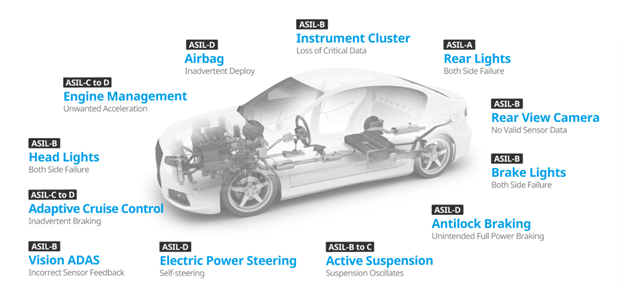A normal vehicle, on average, contains between 30 and 70 Electronic Control Units (ECUs) and modern or luxury vehicles have up to 150 ECUs. Today, the electronic systems offered in automobiles serve as a differentiator, and the trend appears to be continuing to make vehicles smarter electronic devices. As the demand for electronic systems increases, the automobile manufacturers and system suppliers work hard to make them available. The problem for automakers is that with the increased usage of electric vehicles, new potential hazards may develop.
According to the motor vehicle safety data by the BTS (Bureau of Transportation Statistics), more than 6 million crashes involving motor vehicles are reported every year on an average.
ECU is an embedded system in automobile electronics that manages the vehicle’s electrical systems and subsystems. Engine Control Modules (ECM), Powertrain Control Modules (PCM), Electronic Brake Control Modules (EBCM), and General Electronic Modules (GEM) are examples of important ECUs. Because of the importance of passenger safety, managing the rising complexity and quantity of ECUs in a vehicle has become a major issue for OEMs. To ensure a tolerable level of risk, safety has become a basic need in automobile systems. IEC 61508 – International Electrotechnical Commission (IEC), an IEC functional safety standard for the general electronics industry, and ISO 26262 (IEC), an ISO functional safety standard for automobiles, are used to describe safety.
What is the significance of functional safety and its standards?
Safety is critical since lives and reputations are at risk. Software are being used much more in the development of safety-critical products such as vehicles, aircraft, and medical devices. Furthermore, the software must be safe, secure, and stable. As a result, safety guidelines for embedded system developers have been developed across a variety of sectors.
Various industries that are safety-critical must comply with safety regulations. Following are a few key standards that must be met before the product can be declared functionally safe.
| IEC 61508 | The overarching safety standard is IEC 61508. It encompasses electric, electronic, and programmable electronic systems that are used for safety. Using Safety Integrity Levels, this standard assures risk minimization. |
| ISO 26262 | The automobile industry’s safety standard is ISO 26262. It refers to the electric and electronic systems found in commercial vehicles. The Automotive Safety Integrity Levels (ASILs A–D) are used to assess risk in this standard. |
| EN 50128 | EN 50128 is a standard for railways. It covers electrical and electronic equipment used in railway control and protection. In this standard, safety requirements are defined using Software Safety Integrity Levels (SSILs 0–4). |
| IEC 62304 | IEC 62304 is a safety standard used in the medical device industry. It covers the procedures involved in the software lifecycle. This standard combines software safety classification (Classes A–C) to describe criteria depending on risk. |
| IEC 62061 | IEC 62061 is a safety standard that is commonly used in the machinery industry. It applies to electric, electronic, and programmable electronic control systems. |
| IEC 60880 | IEC 60880 is a nuclear power plant safety standard. It applies to software that performs safety functions. |
What are Automotive Safety Integrity Levels (ASIL) in the Automotive industry?
The term ASIL stands for Automotive Safety Integrity Level. The ISO 26262 standard defines it as a risk classification method for the functional safety of road vehicles.
ISO 26262 identified four ASILs: A, B, C, and D. The lowest level of automobile danger is ASIL A, and the highest level is ASIL D.

Automotive Safety Issue Types. Image Credit: ABLIC
(https://www.ablic.com/en/semicon/products/automotive/asil/)
ASILs are determined by hazard analysis and risk assessment. Engineers assess three key characteristics for each electronic component in a vehicle:
Severity – the severity of the driver’s and passengers’ injuries.
Exposure – how frequently the vehicle is confronted with the hazard.
Possibility of control – how much the driver can do to avoid accidents.
The Society of Automotive Engineers proposed a J2980 framework that describes a technique for evaluating the ASIL for automotive electrical and electronic (E/E) systems.
NXP Semiconductors offer a wide range of automotive products for applications such as ADAS and highly automated driving, connectivity, vehicle networking, functional safety, and automotive security. NXP has introduced S32 MCUs and MPUs for automotive applications that have a design that combines performance and power economy. This platform is intended to address the present and future difficulties in connectivity, security, and safety. They provide a complementary S32 Design Studio as part of the overall solution that comprises a comprehensive automotive-grade SDK with low-level drivers and ecosystem support.
The exclusive partnership between eInfochips and NXP Semiconductors delivers technology services to a global client base in IoT, home and industrial automation, automotive, infotainment systems, and medical devices. eInfochips’ expertise in ADAS/autonomous vehicles, HEMS/EV charging, V2X, telematics, infotainment, and multimedia helps global OEMs and Tier1s provide a superior experience, safety, and efficiency. For more information, contact us.













